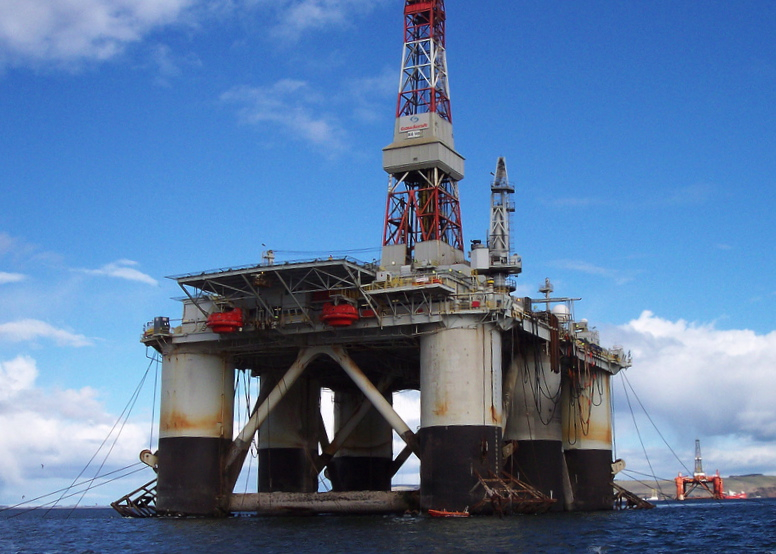ប្រេង និងឧស្ម័នត្រូវបានរកឃើញនៅលើទឹកដី ប្រទេសកម្ពុជា ប៉ុន្តែមិនមានការទាញយកជាលក្ខណៈឧស្សាហកម្មណាមួយបានចាប់ផ្តើមនៅឡើយទេ។ ផលិតផលប្រេងគ្រប់ប្រភេទសម្រាប់បំពេញតម្រូវការក្នុងស្រុកត្រូវបាននាំចូល។ តួរលេខតម្រូវការប្រេងឥន្ធនៈប៉ានស្មានគឺ ៤៧ ៤៩០បារ៉ែលក្នុងមួយថ្ងៃ។ ការប្រើប្រាស់នេះកំពុងនឹងកើនឡើង។ កម្ពុជាបាននាំចូលប្រេងចំនួន ៤៥៣ ០០០តោន ក្នុងរយៈពេល៣ខែដំបូងនៃឆ្នាំ២០១៤ ដែលជាកំណើន ១០% បើធៀបទៅនឹងរយៈពេលដដែលក្នុងឆ្នាំ២០១៣។1

Global Santa Fe Rig 140។រូបភាព ថតដោយ Steven Straiton កាលពីថ្ងៃទី២១ ខែមីនា ឆ្នាំ ២០០៤។ អាជ្ញាប័ណ្ណ៖ BY-NC-ND 2.0
ចំពោះការរ៉ុករកប្រេង និងឧស្ម័ន ប្រទេសកម្ពុជាមានប្លុកចំនួន៦ ដែលស្ថិតនៅក្នុងដែនសមុទ្រ (A-F) ប្លុកចំនួន១៩ ស្ថិតនៅលើដីគោក (I–XIX) និងប្លុកចំនួន៤ទៀត ស្ថិតនៅក្នុងតំបន់ត្រួតស៊ីគ្នា (OCA) ដែលមានជម្លោះជាមួយប្រទេសថៃ។ប្លុក A អាចនឹងផលិតបានប្រេងមុនគេ ប្រសិនបើកត្តាសេដ្ឋកិច្ចអំណោយផល និងមានកិច្ចព្រមព្រៀងរវាងក្រុមហ៊ុនផលិតករ និងរដ្ឋាភិបាលកម្ពុជា។
ច្បាប់ស្តីពីប្រេង និងឧស្ម័ននៅកម្ពុជា
ក្រោមរដ្ឋធម្មនុញ្ញនៃព្រះរាជាណាចក្រកម្ពុជា រាល់ធនធានរ៉ែទាំងអស់ជាទ្រព្យសម្បត្តិរបស់រដ្ឋ។2មិនមានច្បាប់ជាក់លាក់ណាមួយដែលគ្រប់គ្រងលើវិស័យប្រេង និងឧស្ម័ននៅក្នុងប្រទេសកម្ពុជានោះទេ ហើយវិស័យនេះត្រូវបានគ្រប់គ្រងដោយបទប្បញ្ញត្តិប្រេងកាតដែលបានធ្វើវិសោធនកម្មនៅឆ្នាំ ១៩៩១។ នៅឆ្នាំ១៩៩៨ រដ្ឋាភិបាលបានបង្កើតអាជ្ញាធរប្រេងកាតជាតិកម្ពុជា ដែលស្ថិតនៅក្រោមក្រសួងរ៉ែ និងថាមពលសម្រាប់គ្រប់គ្រងធនធានប្រេងកាត។អាជ្ញាធរប្រេងកាតជាតិកម្ពុជាទទួលខុសត្រូវលើការវាយតម្លៃសំណើរ និងផ្តល់អនុសាសន៍ដល់រដ្ឋាភិបាល សម្រាប់ការផ្តល់កិច្ចព្រមព្រៀងប្រេងកាតទៅកាន់ក្រុមហ៊ុនជាក់លាក់ណាមួួយ ។3
*កម្ពុជាប្រើប្រាស់កិច្ចព្រមព្រៀងប្រេងកាត (ឬកិច្ចសន្យាចែករំលែកផលិតកម្ម)សម្រាប់ក្រុមហ៊ុនដែលមានអាជ្ញាប័ណ្ណដើម្បីអនុវត្តការរុករកប្រេងកាត។ យោងតាមគេហទំព័រអាជ្ញាធរប្រេងកាតជាតិកម្ពុជា កិច្ចសន្យាចែករំលែកផលិតកម្ម រួមមានសមាសធាតុមូលដ្ឋានដូចខាងក្រោម៖
- រយៈពេល ៖ ការរុករក ៤ + ២ + ២ ឆ្នាំ ការអភិវឌ្ឍរយៈពេល ៣ ឬ ៤ឆ្នាំ
- ផលិតកម្ម ៖ រហូតល់ ៣០ឆ្នាំ + ៥ឆ្នាំ
- កាតព្វកិច្ចរុករក ៖ អនុវត្តការសិក្សាអង្កេតសេស្មិច 2-D និង 3-D។ ខួងអណ្តូង ១ ទៅ ២។
- ថ្លៃសួយសារ ៖ ១២.៥%
- បុព្វលាភចុះហត្ថលេខា ៖ អាចចរចាបាន
- បុព្វលាភផលិតកម្ម ៖ អាចចរចាបាន
- ការរំលស់ការចំណាយ ៖ អាចចរចាបាន
- ការបែងចែកប្រាក់ចំណេញពីប្រេង ៖ អាស្រ័យលើកត្តាជាក់ស្តែង
- ការបែងចែកប្រាក់ចំណេញពីឧស្ម័ន ៖ អាស្រ័យលើកត្តាជាក់ស្តែង
- ពន្ធលើប្រាក់ចំណូល ៣០%
- កាតព្វកិច្ចទីផ្សារក្នុងស្រុក ៖ ត្រូវបំពេញតាមតម្រូវការក្នុងប្រទេសកម្ពុជា
- ការចូលរួមរបស់ភាគី ៖ រដ្ឋាភិបាលត្រូវមានសិទ្ធិចូលរួមក្នុងប្រតិបត្តិការប្រេងស្ថិតក្រោមកិច្ចព្រមព្រៀងប្រេងកាត។
បទដ្ឋានផ្សេងទៀតសម្រាប់សុវត្ថិភាព និងសន្តិសុខ ត្រូវបានដាក់ចេញនៅក្នុងបទប្បញ្ញាតិ្តទាំងនេះថា ជាលក្ខខណ្ឌតម្រូវដែលអ្នកចុះកិច្ចសន្យាត្រូវការពារបរិស្ថានមូលដ្ឋាន សុខភាព និងសុវត្ថិភាពរបស់កម្មករ។ 4 ការវាយតម្លៃពីផលប៉ះពាល់បរិស្ថាន (EIA) ពេញលេញមួយ ក៏តម្រូវឲ្យធ្វើឡើងសម្រាប់ប្រតិបត្តិការប្រេង និងឧស្ម័នទាំងអស់ផងដែរ5 ប្រតិបត្តិករទាមទារឱ្យផ្តល់ឯកសារមួយចំនួនដូចជាផែនការគ្រប់គ្រងសុវត្ថិភាព ផែនការឆ្លើយតបសង្គ្រោះបន្ទាន់និងផែនការយថាភាពនៃការហៀរកំពប់ប្រេង។ហើយអ្នកអនុវត្តគម្រោង តម្រូវឲ្យគោរពតាមក្របខ័ណ្ណច្បាប់ដែលពាក់ព័ន្ធទាំងអស់ រួមទាំងច្បាប់ស្តីពីបរិស្ថាន និងបទប្បញ្ញាត្តិពាក់ព័ន្ធផ្សេងទៀត។ ប្រតិបត្តិករ ក៏តម្រូវឲ្យដាក់ជូននូវផែនការគ្រប់គ្រងសុវត្ថិភាព ផែនការឆ្លើយតបទៅនឹងគ្រោះអាសន្ន និងផែនការត្រៀមទុកជាមុនក្នុងគ្រាមានការហៀរកំពប់ប្រេងផងដែរ។
ប្រទេសកម្ពុជា មិនមានរោងចក្រចម្រាញ់ប្រេងដែលមានសមត្ថភាពផលិតប្រេង និងឧស្ម័នដែលអាចទាញយកបាននោះទេ ទោះបីជានៅដើមឆ្នាំ២០១៥ ក្រុមហ៊ុនប្រេងកាតកម្ពុជាបានបញ្ជាក់ថារោងចក្រចម្រាញ់ប្រេងតម្លៃ ២.៣ ពាន់លានដុល្លាររបស់ខ្លួននឹងត្រូវសាងសង់នៅលើផ្ទៃដី ៣៦៥ ហិកតាកាត់ខេត្តកំពត និងខេត្តព្រះសីហនុនោះ កំពុងស្ថិតក្នុងដំណាក់កាលដំបូងនៃការសាងសង់ក៏ដោយ។6
ការអភិវឌ្ឍ ក្របខ័ណ្ឌច្បាប់សម្រាប់ការទាញយកប្រេង និងឧស្ម័ននិងការអភិវឌ្ឍបទប្បញ្ញត្តិ រដ្ឋបាល និងសមត្ថភាពគ្រប់គ្រងរបស់អាជ្ញាធរប្រេងកាតជាតិកម្ពុជា(CNPA)មានសារៈសំខាន់ណាស់ ដើម្បីធានាឱ្យបាននូវការប្រកួតប្រជែង និងតម្លាភាព ក៏ដូចជា ការពារផលប្រយោជន៍របស់វិនិយោគិន អតិថិជន បរិស្ថាន និងប្រជាជនមូលដ្ឋានផងដែរ។ ទីភ្នាក់ងារអភិវឌ្ឍន៍អន្ដរជាតិ និងគ្រឹះស្ថានហិរញ្ញវត្ថុជាច្រើន បានផ្តល់ឬកំពុងផ្តល់ការផ្គត់ផ្គង់ផ្នែកបច្ចេកទេស និងហិរញ្ញវត្ថុដល់រដ្ឋាភិបាល ដើម្បីសម្រាប់ឱ្យបានកម្មវត្ថុនេះ ហើយរដ្ឋាភិបាលកំពុងព្យាយាមអភិវឌ្ឍក្របខណ្ឌច្បាប់សម្រាប់គ្រប់គ្រងធនធានប្រេងដ៏ពេញលេញមួយ។ ច្បាប់ប្រេងកាតថ្មីនេះនឹងត្រូវបានអមដំណើរដោយអនុក្រឹត្យស្តីអំពីបទប្បញ្ញត្តិសម្រាប់ការអនុវត្ត។
បើមានការគ្រប់គ្រងត្រឹមត្រូវ វិស័យនេះអាចផ្តល់ប្រាក់ចំណូលគួរឱ្យកត់សម្គាល់ទៅក្នុងសេដ្ឋកិច្ចរបស់ប្រទេសកម្ពុជា។ លោកនាយករដ្ឋមន្ត្រីហ៊ុនសែនបានថ្លែងក្នុងឆ្នាំ ២០០៧ថា៖ “ចំណូលពីអណ្តូងប្រេងដែលទើបនឹងរកឃើញថ្មីនឹងផ្តល់ថវិកាបន្ថែមទៀតសម្រាប់ការអភិវឌ្ឍគម្រោងហិរញ្ញប្បទានក្នុងប្រទេសកម្ពុជា។ ប្រាក់ចំណូលទាំងនេះនឹងផ្តល់ទៅកាន់ការវិនិយោគប្រកបដោយប្រសិទ្ធិភាពនិងការកាត់បន្ថយភាពក្រីក្រ … ពួកយើងនឹងប្រាកដថាប្រេងជាលាភសក្ការៈមិនមែនជាបណ្តាសាសម្រាប់កម្ពុជានោះទេ “។7
ធ្វើបច្ចុប្បន្នភាពនៅថ្ងៃទី១៦ ខែមករា ឆ្នាំ២០១៦
ឯកសារយោង
- 1. “ការនាំចូលប្រេងមកកម្ពុជាកើនឡើង១០ភាគរយក្នុងត្រីមាសទីមួយ”, ដឺខេមបូឌា ហឺរេត,ថ្ងៃទី២០ ខែឧសភា ឆ្នាំ២០១៤។ ចូលអាននៅថ្ងៃទី៧ ខែឧសភា ឆ្នាំ២០១៥។ https://www.cia.gov/library/publications/the-world-factbook/geos/cb.html
- 2. រដ្ឋធម្មនុញ្ញនៃព្រះរាជាណាចក្រកម្ពុជា, មាត្រាទី៥៨.
- 3. សេចក្តីសម្រេចលេខ ៧៣ទៅលើវិសោធនកម្មលើជំពូកទី០២នៃបទបញ្ញាត្តិប្រេងកាត ឆ្នាំ១៩៩១ (ចុះថ្ងៃទី១៨ ខែតុលា ឆ្នាំ១៩៩៨) និង សេចក្តីសម្រេចលេខ ២៥ ទៅលើវិសោធនកម្មនៃបទបញ្ញាត្តិប្រេងកាត ឆ្នាំ១៩៩១(ចុះថ្ងៃទី១៩ ខែមីនា ឆ្នាំ១៩៩៩).
- 4. បទបញ្ញាត្តិប្រេងកាតឆ្នាំ១៩៩៩ , មាត្រាទី២៥.
- 5. អនុក្រឹត្យស្តីពី ការវាយតម្លៃ ផលប៉ះពាល់បរិស្ថាន ដំណើរការ ឆ្នាំ ១៩៩៩ ឧបសម្ព័ន្ធលើរង្វាយតម្លៃផលប៉ះពាល់បរិស្ថានឆ្នាំ១៩៩៩.
- 6. ចន្ទ មុយហួង, ឆ្នាំ២០១៥. “មិនមានសញ្ញាណបញ្ចប់ទៅលើការប្រកួតប្រជែង នៃរោងចក្រឧស្ម័ននោះទេ”, ការសែតភ្នំពេញបុស្តិ៍ ថ្ងៃទី៣ មេសា ឆ្នាំ២០១៥. http://www.phnompenhpost.com/business/no-end-date-sight-oil-plant-completion
- 7. ការសែតឆាយណា ភីផលដេលី ឆ្នាំ២០០៧. “សក្តានុពលប្រេងបម្រុងបានដាក់ ប្រទេសកម្ពុជាធ្វើឱ្យកម្ពុជាទទួលបានការចាប់អារម្មណ៍” ថ្ងៃទី២៤ ខែកុម្ភៈ ឆ្នាំ២០០៧.

